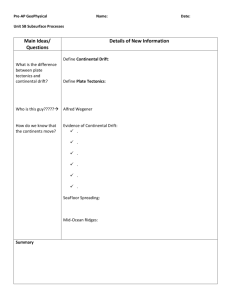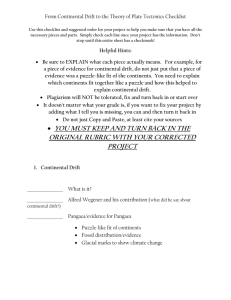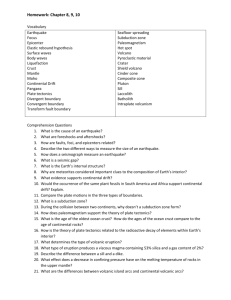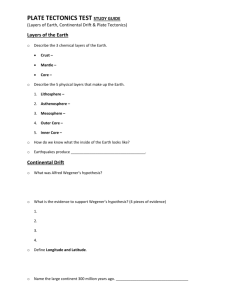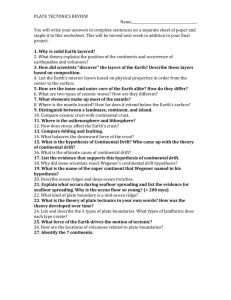Grade 8 - Earth Science - Tectonics
advertisement
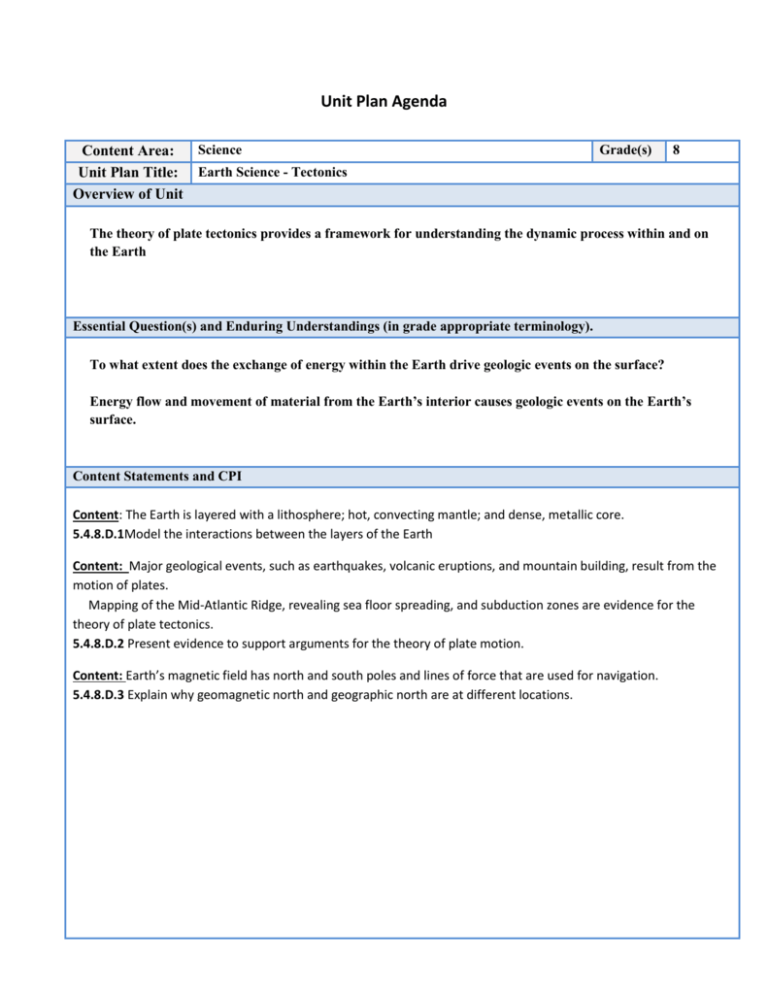
Unit Plan Agenda Science Content Area: Unit Plan Title: Earth Science - Tectonics Overview of Unit Grade(s) 8 The theory of plate tectonics provides a framework for understanding the dynamic process within and on the Earth Essential Question(s) and Enduring Understandings (in grade appropriate terminology). To what extent does the exchange of energy within the Earth drive geologic events on the surface? Energy flow and movement of material from the Earth’s interior causes geologic events on the Earth’s surface. Content Statements and CPI Content: The Earth is layered with a lithosphere; hot, convecting mantle; and dense, metallic core. 5.4.8.D.1Model the interactions between the layers of the Earth Content: Major geological events, such as earthquakes, volcanic eruptions, and mountain building, result from the motion of plates. Mapping of the Mid-Atlantic Ridge, revealing sea floor spreading, and subduction zones are evidence for the theory of plate tectonics. 5.4.8.D.2 Present evidence to support arguments for the theory of plate motion. Content: Earth’s magnetic field has north and south poles and lines of force that are used for navigation. 5.4.8.D.3 Explain why geomagnetic north and geographic north are at different locations. Student Learning Targets/Objectives: should be connected to content statements. Students will be able to: e.g.: 1- Articulate predictions and imagine ways to test those predictions, using practice gained through class explorations of water quality in the school pond and water supply. Students will be able to explain, apply and investigate the following information: 1. The layers of the Earth and the composition of each 2. The concept of Continental Drift and how plate tectonics justifies the theory. 3. What the Earth looked like over the past 200 million years and the evidence that supports this. 4. What the Earth will look like 100 million years from now and why. 5. How seafloor spreading and the mid-atlantic ridge helps to justify continental drift 6. How other natural phenomenon (earthquakes, volcanoes etc) have helped to shape the surface of the Earth over the past 200 million years Strategies/Justifications 1. Notebooking will help students clarify their own thinking, identify weaknesses and document progress. 2. Probe and lesson starter questions will help direct student thinking, introduce the topic and uncover misconceptions. 3. Use of Turning Point clickers will reinforce ideas, check for understanding and measure prior knowledge 4. Labs and activities will provide hands on inquiry based learning and allow students to work together collaboratively to solve a problem or discover an enduring understanding 5. Online resources give visual aid to the students and present information in a different way. Activities, Lessons, and Assessments Time Frame Teaching Point: Many geologic factors have contributed to the changing of the Earth’s surface over the past 4.5 billion years. Focus Question/Notebook: What factors have caused the Earth to change over the past 4.5 billion years? Notebook and discuss. Have students discuss what they think they know and how forces have contributed to the changes in the Earth’s surface. Guide students toward plate tectonics, glaciers and other factors that have had a large impact on the Earth. 1 hour Teaching Point: The Continental Drift Theory illustrates the drastic changes in the Earth’s surface and where the continents are positioned. Notebook: Draw a diagram of what the surface of the Earth looked like 300 million years ago. Interactives: Dynamic Earth – Use website to illustrate layers of the Earth and changes in the Earth’s surface. Works as a jumping off point and supplement to concepts needed. http://www.learner.org/interactives/dynamicearth/index.html . Have students work through the website, answering questions that relate to each section (see attached) Investigating Plate Tectonics Activity 1-2 hours Teaching Point: Scientists have used clues from the past to understand how the Earth has changed over time. Notebook: How were scientists able to discover that Continental Drift has occurred? Theory of plate tectonics: Read and discuss article: “Flipped from Head to Toe: 100 Years of Continental Drift Theory” http://www.sciencedaily.com/releases/2012/01/120104133151.htm Discuss history and methods of determining continental drift. http://pubs.usgs.gov/gip/dynamic/understanding.html 1 hour Teaching Point: Ocean floor spreading is one way the continents have moved over the past 300 million years. Notebook: Define sea floor spreading. Speculate one place on Earth that this is currently taking place. Mid-Atlantic Ridge Activity: Create 2 maps showing the depth of the ocean floor from New Jersey to Portugal. One map is a depth chart, one is a topography map. Use as a way to show how the face of the Earth is changing and how slow the process is. 1 hour Teaching Point: various natural disasters that shape the Earth’s surface Notebook: How do natural disasters shape the Earth’s surface? Review of natural disasters (earthquakes, volcanoes, etc) and how they have helped to shape the surface of the earth over the past 200 million years. Natural disasters activity (see attached) Teaching Point: Use plate boundary information to predict what the Earth will look like in 100 million years Notebook: What will the Earth look different in 100 million years? Create three diagrams showing the Earth’s tectonic boundaries; past, present and future. (see attached) 1-2 hours 1 hour Resources that need to be ordered or located. Investigating Plate Tectonics Class Activity (Science Kit) Technology to be integrated (tools, equipment, software, and online learning)

